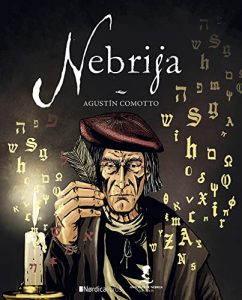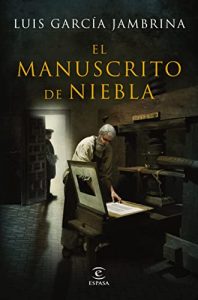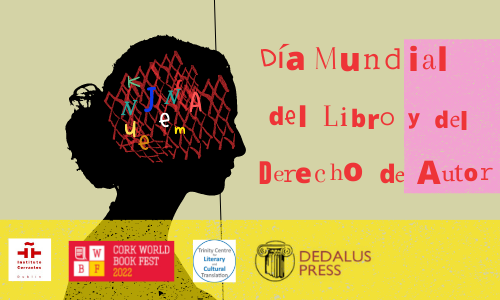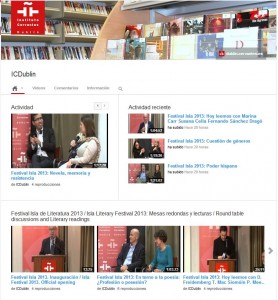Blog del Instituto Cervantes de Dublín
Torre Martello
Lucha por la libertad de expresión. Derechos de autor y Elio Antonio de Nebrija | Fight for Free Thinking. Copyright and Elio Antonio de Nebrija
El 23 de abril se celebra el Día Mundial del Libro y del Derecho de Autor y lo celebramos con varios encuentros literarios, pero ahora, vamos a conocer un poco más la relevancia de Elio Antonio de Nebrija y los derechos de autor.
Es habitual pensar que un objeto que has creado es de tu propiedad, ya sea un cuadro, un libro o, incluso, una idea. El derecho de autor es algo tan natural para nosotros como las cerraduras de nuestras casas. Sin embargo, no siempre fue así: en el pasado, los escritores vieron que sus obras eran copiadas y libremente revendidas. La entrada de hoy trata de un español que hizo posible que los autores se ganaran la vida con su creatividad. Escribió uno de los primeros bestseller de la historia y reclamó su propiedad intelectual. Se llamaba Elio Antonio de Nebrija y este año se cumple el 500 aniversario de su muerte.
¿Cómo funcionaban los derechos de autor en el pasado?
No sabemos exactamente qué pensaban los antiguos griegos de la misma idea de copyright, pero seguramente les sorprendería saber que hoy en día algunos autores viven de sus libros. Era una práctica normal copiar las obras literarias a mano para difundirlas. Los autores, evidentemente, no eran remunerados por cada copia. En la época medieval no había una necesidad real de derechos de autor, ya que incluso los aristócratas y los monarcas no tenían el hábito de leer a diario. Los libros se escribían en latín — la lengua que hablaban sobre todo los monjes.
¿Por qué Nebrija no solo pudo hacer carrera con la publicación de sus libros, sino también beneficiarse económicamente?
Nebrija nació en 1444, unos años después de que se inventara la imprenta. Fue entonces cuando comenzó oficialmente el negocio de la imprenta: al obtener el derecho de reimpresión, se podían copiar las obras durante años. Sin embargo, los autores solo recibían una pequeña recompensa y tenían que buscar otras maneras para ganarse la vida. Antonio de Nebrija fue realmente el pionero en defender el derecho del escritor a pensar y crear sin restricciones económicas.
¿Quién fue esta persona y por qué es tan importante para quien quiera dedicarse al hispanismo?

1492 es la fecha que todos los hispanistas memorizan para su primer examen. Para la mayoría de nosotros, la asociación con ella sería el descubrimiento de América. Sin embargo, Nebrija creó un vínculo aún más fuerte con esta fecha en el corazón de los filólogos al escribir la primera Gramática Castellana en ese mismo año. En un mundo en el que casi todos los libros se seguían publicando en latín y en el que las numerosas lenguas que se hablaban en la Península Ibérica (castellano, catalán, occitano, euskera, gallego, etc.) se consideraban vulgares, este libro fue una revelación que sólo podía crear un pensador liberal. Además, Nebrija contribuyó a dar fama a España, al crear un “libro de texto” internacional, Introductiones latinae (Salamanca, 1481) que se publicó cientos de veces y se difundió por toda Europa.
Nebrija fue un verdadero humanista polifacético, y sus numerosas habilidades y talentos le hicieron ser recordado como historiador, catedrático, traductor, exégeta, cronista real y poeta. Creía que la lengua castellana era una fuerza de unión para las tierras de los Reyes Católicos. Estos monarcas eran los que él veneraba (incluso dedicó su Gramática castellana a la reina Isabel). Al mismo tiempo, este régimen le puso, paradójicamente, en las manos de la inquisición. Nebrija tuvo que someterse a un juicio político por intentar interpretar la Biblia utilizando fuentes del griego y el hebreo antiguos en lugar del latín. Tras ser absuelto, publicó Apología (1507), la primera declaración seria contra la censura y a favor del pensamiento y la expresión libres.
Nuestras recomendaciones de lectura sobre Nebrija
– Nebrija de Agustín Comotto (Nórdica, 2022): un cómic magistral que narra la biografía y los logros más importantes del erudito.
– El manuscrito de Niebla de Luis García Jambrina (Espasa, 2022): la historia de edición de libros en la época de Nebrija contada en forma de novela detectivesca.
Texto de Ekaterina Dragalina
Fight for Free Thinking. Copyright and Elio Antonio de Nebrija
On April 23rd we celebrate the World Book and Copyright Day. During that week, we will present a programme of events for all audiences. But now, let’s discover the importance of Elio Antonio de Nebrija and his relation with Copytight.
It is common to think that an object that you created belongs to you, regardless of whether it is a painting, a book or even an idea. Authors’ copyright is something as natural to us as locks on our houses. However, it was not always like this: in the past, literary authors had their creations copied and resold by others for free and without a second thought. Today’s article is about a Spanish man who made it possible for authors to make a living out of their creativity. He sold one of the first book bestsellers in history and claimed its ownership. His name was Elio Antonio de Nebrija, and this year marks the 500th anniversary of his death.
How did copyright work in the past?
We don’t exactly know what ancient Greeks thought of the idea of copyright, but surely, they would be surprised to know that nowadays authors live off their books. It was a normal practice to copy literary works by hand in order to spread the word about them. The authors did not get any profit from that action. In the Medieval times, there was no actual need for copyright, since even aristocrats and monarchs did not have a habit of reading daily. Books were written in Latin – the language that mostly monks spoke.

Why was Nebrija able to not only make a career out of publishing his books, but also profit from it financially?
Nebrija was born in 1444, a few years after the printing press was invented. This is when the printing business officially started: by getting the privilege of reprint, the publishers could freely copy the works for several years. However, the authors were only getting a small reward and had to search for other ways to make a living. Antonio de Nebrija was truly the pioneer of defending the writer’s right to think and create without financial restrictions.
Who was this person and why is he so important for anyone who wants to get serious about Spanish studies?
1492 is the date that all the hispanists memorize for their very first exam. For most of us, the association with it would be the discovery of America. However, Nebrija created even a stronger bond to it in the philologists’ hearts by writing the first Castilian Grammar (Gramática Castellana) in the same year. In the world where almost all the books were still published in Latin, and the many languages spoken in the Iberian Peninsula (Castilian, Catalan, Occitan, Basque, Galician, etc.) were considered vulgar, this book was truly a sensation that could be created only by a liberal thinker. Moreover, Nebrija created a fame for Spain by creating an international “textbook”, Introductiones latinae (Salamanca, 1481), which was published hundreds of times and spread all over Europe.
Nebrija was a real multifaceted humanist, and his numerous skills and talents made him remembered as a historian, a scholar, a translator, an exegete, a royal chronicler, and a poet. He believed the Castillian language to be a uniting force that would bond the lands of the Catholic Monarchs together. These monarchs were the ones he revered (he even dedicated his Castilian Grammar to Queen Isabel). At the same time, their regime paradoxically sent him to the hands of inquisition. Nebrija had to go through an impeachment trial for trying to interpret the Bible using sources from Ancient Greek and Hebrew instead of only Latin. After his acquittal, he published Apology (Apología, 1507) – the first serious statement against censorship and in favor of free thinking and expression.
Recommended new book releases about the life of Nebrija
- Nebrija by Agustín Comotto (Nórdica, 2022): a masterfully made comic book narrating the biography and the most important achievements of the scholar.
- El manuscrito de Nieblaby Luis García Jambrina (Espasa, 2022): the history of book publishing in Nebrija’s epoque told in the form of a detective story
Text by Ekaterina Dragalina




